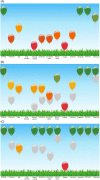Home monitoring of lung function, symptoms and quality of life after admission with COVID-19 infection: The HOMECOMIN' study
- PMID: 35441433
- PMCID: PMC9115460
- DOI: 10.1111/resp.14262
Home monitoring of lung function, symptoms and quality of life after admission with COVID-19 infection: The HOMECOMIN' study
Abstract
Background and objective: To develop targeted and efficient follow-up programmes for patients hospitalized with coronavirus disease 2019 (COVID-19), structured and detailed insights in recovery trajectory are required. We aimed to gain detailed insights in long-term recovery after COVID-19 infection, using an online home monitoring programme including home spirometry. Moreover, we evaluated patient experiences with the home monitoring programme.
Methods: In this prospective multicentre study, we included adults hospitalized due to COVID-19 with radiological abnormalities. For 6 months after discharge, patients collected weekly home spirometry and pulse oximetry measurements, and reported visual analogue scales on cough, dyspnoea and fatigue. Patients completed the fatigue assessment scale (FAS), global rating of change (GRC), EuroQol-5D-5L (EQ-5D-5L) and online tool for the assessment of burden of COVID-19 (ABCoV tool). Mixed models were used to analyse the results.
Results: A total of 133 patients were included in this study (70.1% male, mean age 60 years [SD 10.54]). Patients had a mean baseline forced vital capacity of 3.25 L (95% CI: 2.99-3.44 L), which increased linearly in 6 months with 19.1% (Δ0.62 L, p < 0.005). Patients reported substantial fatigue with no improvement over time. Nevertheless, health status improved significantly. After 6 months, patients scored their general well-being almost similar as before COVID-19. Overall, patients considered home spirometry useful and not burdensome.
Conclusion: Six months after hospital admission for COVID-19, patients' lung function and quality of life were still improving, although fatigue persisted. Home monitoring enables detailed follow-up for patients with COVID-19 at low burden for patients and for the healthcare system.
Keywords: COVID-19; chronic lung disease; coronavirus disease; eHealth; health-related quality of life; home spirometry; patient-reported outcome measures; telemedicine.
© 2022 The Authors. Respirology published by John Wiley & Sons Australia, Ltd on behalf of Asian Pacific Society of Respirology.
Conflict of interest statement
None declared.
Figures




References
-
- World Health Organization . WHO Health Emergency Dashboard. Available from: https://covid19.who.int/. [Cited 28 February 2022].
-
- Halpin SJ, McIvor C, Whyatt G, Adams A, Harvey O, McLean L, et al. Postdischarge symptoms and rehabilitation needs in survivors of COVID‐19 infection: a cross‐sectional evaluation. J Med Virol. 2021;93(2):1013–22. - PubMed
Publication types
MeSH terms
LinkOut - more resources
Full Text Sources
Medical
Research Materials
Miscellaneous

